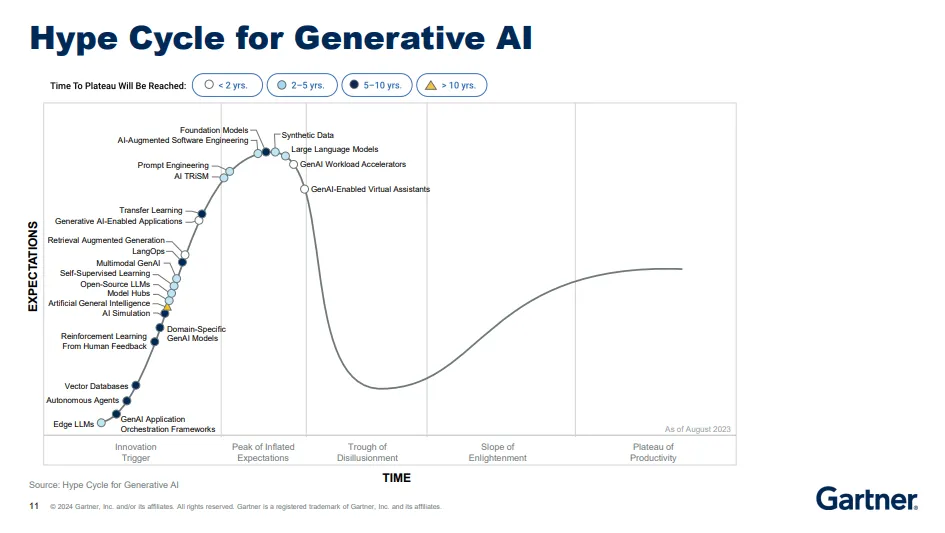Dive Brief:
- The business value of generative AI initiatives is mostly unproven and unestablished, according to Arun Chandrasekaran, distinguished VP analyst at Gartner, speaking during a webinar last week.
- “The ROI and eventual business value of these initiatives are still largely a work in progress,” Chandrasekaran said. “And the extent of workforce productivity, the extent of improvement in customer experience, the extent of improvement in real business value metrics, such as revenue growth or cost reduction, is still to be determined.”
- Most generative AI technologies remain near the beginning of the hype cycle, resting just past the innovation trigger, Gartner said. The analyst firm's hype cycle for technologies has five key points: the innovation trigger, the peak of inflated expectations, the trough of disillusionment, the slope of enlightenment and the plateau of productivity.
Dive Insight:
Enterprises are bullish on generative AI’s potential to transform the business, from operations to user experience.
More than half of organizations are currently piloting or in production with generative AI, according to a September Gartner survey. It’s a 36 percentage point increase from a similar Gartner survey last April.
But the question remains: can generative AI live up to its hype?

Most organizations are prioritizing natural language processing tasks in generative AI deployments, such as summarization, language translation and sentiment analysis, according to Gartner’s research.
Conversational chatbots powered by LLMs have become the go-to spot for organizations to start exploring generative AI. PwC, Deloitte, EY and McKinsey have internal chatbots for employees to quickly gather information and summarize lengthy documents.
General Mills, Kraft Heinz, Procter & Gamble, Walmart, American Honda and countless organizations across industries have joined in as well.
Deploying a conversational tool is just one part of an organization’s overall AI strategy. Tech leaders are looking to embed generative AI to support IT operations via code completion and documentation tools. Gartner anticipates mainstream adoption of AI-augmented software engineering to gain momentum in the next two to five years.
The initial buzz around emerging technologies can obscure downstream impacts. Companies tend to overestimate early benefits and underestimate long-term effects, an application of Amara's law of technology adoption, Chandrasekaran said.
“While the models are advancing at almost breakneck speed, enterprise data engineering and, to an extent, enterprise data quality is still stuck in the 20th century,” Chandrasekaran added.
Data is a key ingredient in the secret sauce that makes generative AI models and tools useful for large enterprises. For organizations to reach their goals, leaders will need to make upfront investments in getting the tech stack up to speed.
“There’s still a lot of progress that we need to make around all of this for us to eventually see value and get to the goal at the top of the mountain,” Chandrasekaran said.













